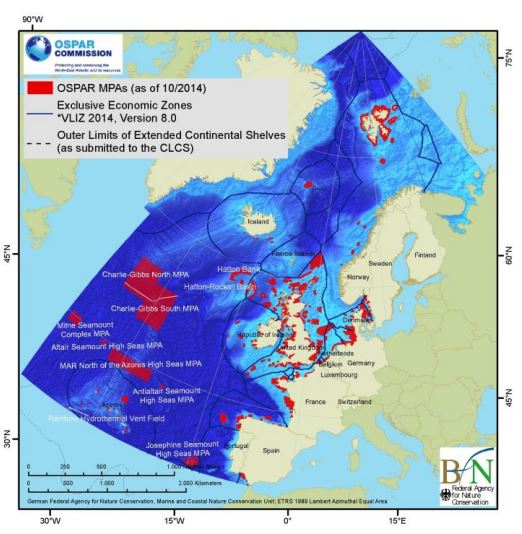OSPAR has released the following press release after the Commission meeting inin Oostende (Belgium), last 26 June.
Here the press release:
This week saw the meeting of the OSPAR Commission in Oostende (Belgium).
One of the key steps forward in protecting the North-East Atlantic was the adoption of Recommendations to protect and conserve a further three species and one habitat identified by OSPAR as being particularly vulnerable within the North-East Atlantic. The Allis Shad, Azorean Limpet, Sea Lamprey and Intertidal Mussel Beds all saw their protection extended. The meeting also agreed to adopt guidelines to reduce the impact of offshore installation lighting on birds in the OSPAR maritime area.
Continued cooperation between OSPAR and the North East Atlantic Fisheries Commission to ensure the conservation of particular areas in the high seas was also welcomed. This ground-breaking arrangement sees both organisations work within their mandates to protect the unique ecosystems found in the mid-Atlantic.
OSPAR also announced that its network of Marine Protected Areas (MPAs) now comprises 413 MPAs. This amounts to the protection of nearly 6% of the OSPAR Maritime Area and puts the OSPAR area far ahead of the global average of 2.8%(1).
The 2014 Status Report on the OSPAR Network of Marine Protected Areas showed that last year alone a further 77 MPAs covering more than 89 397 km2 were added to the OSPAR Network of MPAs, showing OSPAR's continued commitment to creating a network of MPAs that is ecologically coherent and well managed.
Further successes of the meeting saw the finalisation of plans for OSPAR's Intermediate Assessment 2017 which will evaluate the quality status of the North-East Atlantic and take forward OSPAR's vision of a clean, healthy and biologically diverse sea. The Commission also reflected on its enhanced cooperation with the Abidjan Convention.
Mr Victor Escobar (Spain), Chairman of the OSPAR Commission said that OSPAR delegates should "take time to celebrate the successes of the Commission" before going on to remind delegates that they should be "...be proud of the solid foundation of intergovernmental trust and cooperation for which the OSPAR Commission is known". He then reminded delegates that continued cooperation and commitment was vital to the health, enjoyment and economic prosperity of the North-East Atlantic and welcomed the remit agreed to closer cooperation with the Arctic Council.
ENDS
Note for editors
1. The OSPAR Commission was set up by the 1992 OSPAR Convention for the Protection of the Marine Environment of the North-East Atlantic, which unified and updated the 1972 Oslo and 1974 Paris Conventions. It brings together the governments of Belgium, Denmark, Finland, France, Germany, Iceland, Ireland, Luxembourg, the Netherlands, Norway, Portugal, Spain, Sweden, Switzerland and the United Kingdom, together with the European Community.
2. More than 30 international non-governmental organisations are involved in OSPAR as official Observers. They represent a broad range of interests and expertise related to the marine environment and the uses of marine resources. Many contribute information, insights and standpoints. This is much appreciated feedback from civil society and the economy. The OSPAR Commission greatly values these partnerships that help inform its decisions and other results. (See list on OSPAR)
3. The Bergen Statement was adopted at the third Ministerial Meeting of the OSPAR Commission in 2010 in Bergen, Norway.a
4. The 4 marine habitats and species protected in these recommendations bring the total list to 37 species and 15 habitats including those agreed at previous OSPAR meetings. The 4 added to the list today are:
SPECIES; Azorean limpet (Patella aspera), sea lamprey (Petromyzon marinus), Allis shad (Alosa alosa)
HABITAT; intertidal Mytilus edulis beds on mixed and sandy sediments
5. The Abidjan Convention for Cooperation in the Protection, Management and Development of the Marine and Coastal Environment of the Atlantic Coast of the West, Central and Southern Africa Region (Abidjan Convention in short), it covers a marine area from Mauritania to South Africa which has a coastline of just over 14,000 km. The Convention provides an overarching legal framework for all marine-related programmes in West, Central and Southern Africa.
6. The North East Atlantic Fisheries Commission (NEAFC) is the Regional Fisheries Management Organisation (RFMO) for the North East Atlantic, one of the most abundant fishing areas in the world. The area covered by the NEAFC Convention stretches from the southern tip of Greenland, east to the Barents Sea, and south to Portugal. NEAFC's objective is to ensure the long-term conservation and optimum utilisation of the fishery resources in the Convention Area, providing sustainable economic, environmental and social benefits. To this end, NEAFC adopts management measures for various fish stocks and control measures to ensure that they are properly implemented. NEAFC also adopts measures to protect other parts of the marine ecosystem from potential negative impacts of fisheries.
Source: OSPAR (ospar.org)

